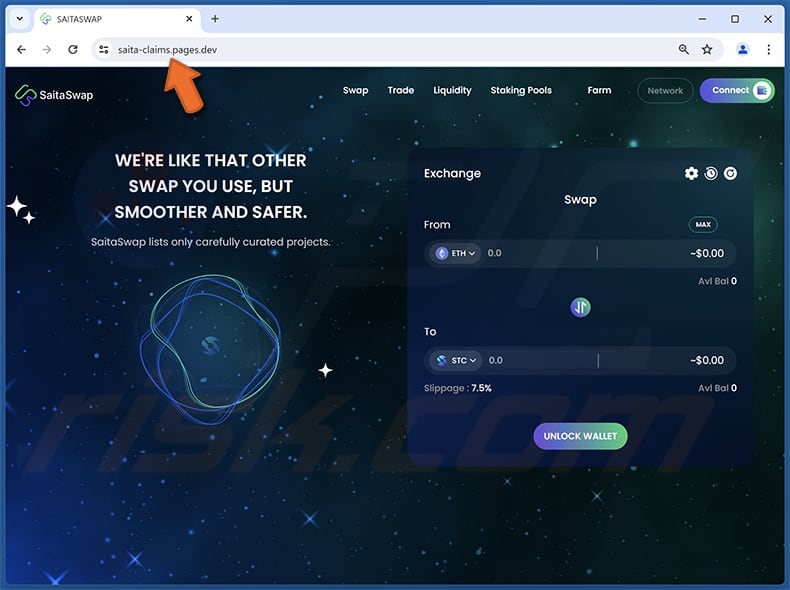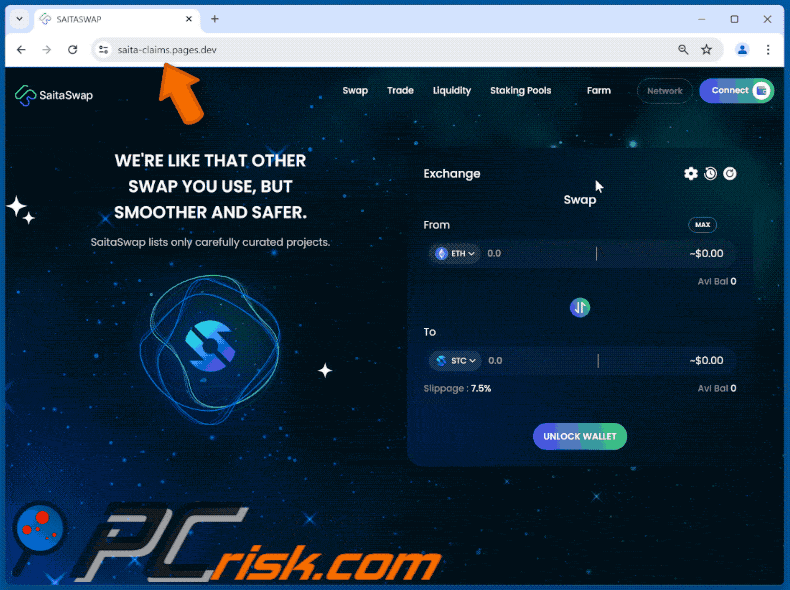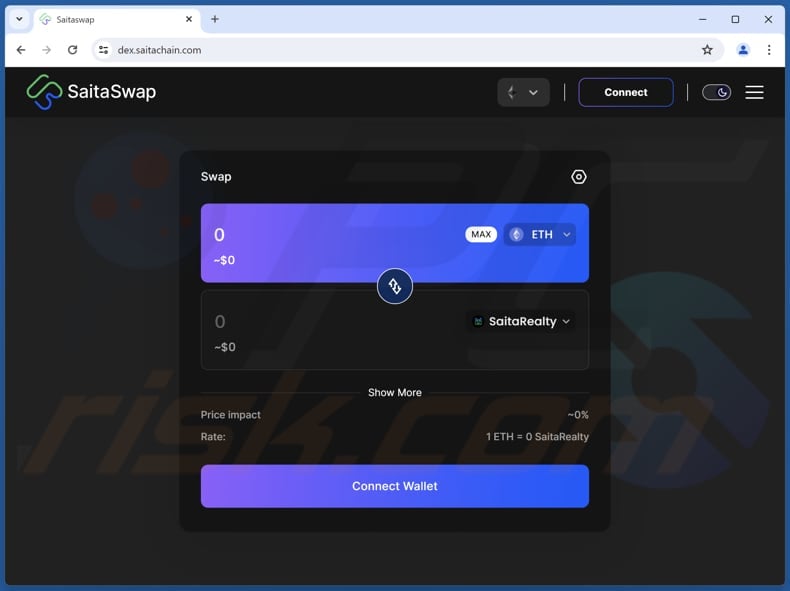How to avoid falling for scams like the fake SaitaSwap website
Phishing/ScamAlso Known As: Fake SaitaSwap platform
Get free scan and check if your device is infected.
Remove it nowTo use full-featured product, you have to purchase a license for Combo Cleaner. Seven days free trial available. Combo Cleaner is owned and operated by RCS LT, the parent company of PCRisk.com.
What is the "Fake SaitaSwap" website?
During our examination, we uncovered that this is a scam web page designed to steal cryptocurrency from unsuspecting individuals. Scammers behind it aim to lure users into believing they are on the real SaitaSwap platform (saitachain.com). Users should be careful with deceptive sites to avoid monetary loss and other issues.

IMPORTANT NOTE: We do not review crypto projects, please do your own research when investing money.
Federal Trade Comission (FTC) states that since the start of 2021, more than 46,000 people have reported losing over $1 billion in crypto to scams – that's about one out of every four dollars reported lost, more than any other payment method.
Fake SaitaSwap website overview
SaitaChain (saitachain[.]com) is a dynamic Web3.0 technology company dedicated to empowering, educating, and simplifying decentralized finance (DeFi) for everyone. Their mission is to make DeFi a practical and accessible tool for daily life.
The scam website is designed to look similar to sitachain [.]com to trick users. On the fake page, users are offered to join the platform by unlocking (connecting) a wallet. However, when users "connect" a wallet, they actually sign a malicious contract. Once this malicious contract is signed, the scam page activates a cryptocurrency drainer.
The purpose of this drainer is to extract cryptocurrency from wallets. It is designed to transfer victim's crypto funds to the scammer's wallet. Since cryptocurrency transactions are irreversible, victims lose their digital assets permanently.
Thus, before engaging with any cryptocurrency platform, users are advised to perform comprehensive research.
| Name | Fake SaitaSwap platform |
| Threat Type | Phishing, Scam, Social Engineering, Fraud |
| Disguise | Legitimate SaitaSwap (saitachain[.]com) platform |
| Symptoms | Unofficial domain, lack of official verification, unrealistic claims, too good-to-be-true promises. |
| Distribution methods | Compromised social media accounts, hijacked WordPress sites, rogue online pop-up ads, phishing emails, unwanted applications. |
| Damage | Loss of sensitive private information, monetary loss, identity theft, possible malware infections. |
| Malware Removal (Windows) |
To eliminate possible malware infections, scan your computer with legitimate antivirus software. Our security researchers recommend using Combo Cleaner. Download Combo CleanerTo use full-featured product, you have to purchase a license for Combo Cleaner. 7 days free trial available. Combo Cleaner is owned and operated by RCS LT, the parent company of PCRisk.com. |
Similar scams in general
Scams like the fake SaitaChain website are designed to deceive users by mimicking real platforms. These fraudulent sites lure users into connecting their wallets, which leads to signing malicious contracts and activating tools designed to steal cryptocurrency.
To avoid falling victim to such scams, it is crucial for users to conduct thorough research before engaging with any cryptocurrency platform. Verifying the platform's legitimacy and reading reviews can help protect users from financial loss and ensure a safer online experience.
Examples of other fake platforms similar to the one described in our article are: "Mint Blockchain Wallet Connect", "HALO Portfolio Tracker", and "Aerodrome $veAERO Voting Rewards" sites.
How did I open a scam website?
Pretty often, scammers who utilize cryptocurrency drainers to steal digital assets use hijacked WordPress sites and stolen social media accounts to trick users into participating in their schemes. Other methods commonly used to promote scams are to send messages or emails containing links, create deceptive ads and pop-ups.
Also, users may land on scam pages via notifications from unreliable pages, ads delivered by adware, and websites that utilize rogue advertising networks (e.g., illegal movie streaming platforms or torrent sites).
How to avoid visiting scam pages?
Always examine website URLs to see whether they match legitimate/official domains. Exercise caution with unexpected emails or messages that include links. Rely on trusted search engines and avoid interacting with pop-ups, ads, buttons, alerts, and similar elements on suspicious websites.
Download apps only from official websites or app stores and regularly update all apps, including security tools and the operating system. Do not allow dubious sites to send notifications. If your computer is already infected with unwanted apps, we recommend running a scan with Combo Cleaner Antivirus for Windows to automatically eliminate them.
The appearance of the fake SaitaSwap website (GIF):

Screenshot of the real page (saitachain[.]com):

Instant automatic malware removal:
Manual threat removal might be a lengthy and complicated process that requires advanced IT skills. Combo Cleaner is a professional automatic malware removal tool that is recommended to get rid of malware. Download it by clicking the button below:
DOWNLOAD Combo CleanerBy downloading any software listed on this website you agree to our Privacy Policy and Terms of Use. To use full-featured product, you have to purchase a license for Combo Cleaner. 7 days free trial available. Combo Cleaner is owned and operated by RCS LT, the parent company of PCRisk.com.
Quick menu:
- What is Fake SaitaSwap platform?
- How to identify a pop-up scam?
- How do pop-up scams work?
- How to remove fake pop-ups?
- How to prevent fake pop-ups?
- What to do if you fell for a pop-up scam?
How to identify a pop-up scam?
Pop-up windows with various fake messages are a common type of lures cybercriminals use. They collect sensitive personal data, trick Internet users into calling fake tech support numbers, subscribe to useless online services, invest in shady cryptocurrency schemes, etc.
While in the majority of cases these pop-ups don't infect users' devices with malware, they can cause direct monetary loss or could result in identity theft.
Cybercriminals strive to create their rogue pop-up windows to look trustworthy, however, scams typically have the following characteristics:
- Spelling mistakes and non-professional images - Closely inspect the information displayed in a pop-up. Spelling mistakes and unprofessional images could be a sign of a scam.
- Sense of urgency - Countdown timer with a couple of minutes on it, asking you to enter your personal information or subscribe to some online service.
- Statements that you won something - If you haven't participated in a lottery, online competition, etc., and you see a pop-up window stating that you won.
- Computer or mobile device scan - A pop-up window that scans your device and informs of detected issues - is undoubtedly a scam; webpages cannot perform such actions.
- Exclusivity - Pop-up windows stating that only you are given secret access to a financial scheme that can quickly make you rich.
Example of a pop-up scam:

How do pop-up scams work?
Cybercriminals and deceptive marketers usually use various advertising networks, search engine poisoning techniques, and shady websites to generate traffic to their pop-ups. Users land on their online lures after clicking on fake download buttons, using a torrent website, or simply clicking on an Internet search engine result.
Based on users' location and device information, they are presented with a scam pop-up. Lures presented in such pop-ups range from get-rich-quick schemes to fake virus scans.
How to remove fake pop-ups?
In most cases, pop-up scams do not infect users' devices with malware. If you encountered a scam pop-up, simply closing it should be enough. In some cases scam, pop-ups may be hard to close; in such cases - close your Internet browser and restart it.
In extremely rare cases, you might need to reset your Internet browser. For this, use our instructions explaining how to reset Internet browser settings.
How to prevent fake pop-ups?
To prevent seeing pop-up scams, you should visit only reputable websites. Torrent, Crack, free online movie streaming, YouTube video download, and other websites of similar reputation commonly redirect Internet users to pop-up scams.
To minimize the risk of encountering pop-up scams, you should keep your Internet browsers up-to-date and use reputable anti-malware application. For this purpose, we recommend Combo Cleaner Antivirus for Windows.
What to do if you fell for a pop-up scam?
This depends on the type of scam that you fell for. Most commonly, pop-up scams try to trick users into sending money, giving away personal information, or giving access to one's device.
- If you sent money to scammers: You should contact your financial institution and explain that you were scammed. If informed promptly, there's a chance to get your money back.
- If you gave away your personal information: You should change your passwords and enable two-factor authentication in all online services that you use. Visit Federal Trade Commission to report identity theft and get personalized recovery steps.
- If you let scammers connect to your device: You should scan your computer with reputable anti-malware (we recommend Combo Cleaner Antivirus for Windows) - cyber criminals could have planted trojans, keyloggers, and other malware, don't use your computer until removing possible threats.
- Help other Internet users: report Internet scams to Federal Trade Commission.
Frequently Asked Questions (FAQ)
What is a fake crypto platform?
A fake crypto platform is a fraudulent website or application that poses as a legitimate cryptocurrency exchange, wallet, or investment service but is designed to scam users.
What is the purpose of a fake crypto platform?
Typically, the purpose of fake crypto platform scams is to steal money (cryptocurrency) or personal information from users.
Why do I encounter scam websites?
Scam websites are primarily promoted through platforms that use unreliable advertising networks (like torrent sites), links shared from hacked social media accounts, or via ads displayed by malicious apps. Fraudulent emails (or messages) containing links, misleading online ads, and notifications from unreliable pages are also used to lure unsuspecting users.
Will Combo Cleaner protect me from pags hosting scams?
Combo Cleaner is designed to analyze web pages and identify untrustworthy ones, including scam sites. When such sites are detected, it alerts users and restricts access to these potentially harmful websites.
Share:

Tomas Meskauskas
Expert security researcher, professional malware analyst
I am passionate about computer security and technology. I have an experience of over 10 years working in various companies related to computer technical issue solving and Internet security. I have been working as an author and editor for pcrisk.com since 2010. Follow me on Twitter and LinkedIn to stay informed about the latest online security threats.
PCrisk security portal is brought by a company RCS LT.
Joined forces of security researchers help educate computer users about the latest online security threats. More information about the company RCS LT.
Our malware removal guides are free. However, if you want to support us you can send us a donation.
DonatePCrisk security portal is brought by a company RCS LT.
Joined forces of security researchers help educate computer users about the latest online security threats. More information about the company RCS LT.
Our malware removal guides are free. However, if you want to support us you can send us a donation.
Donate
▼ Show Discussion